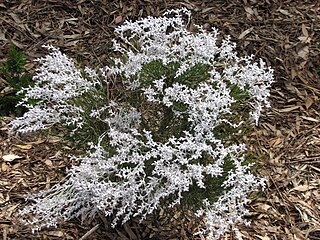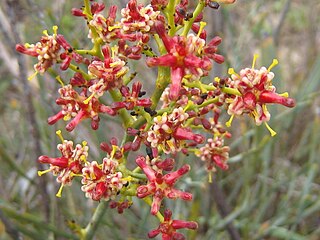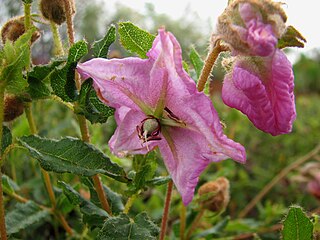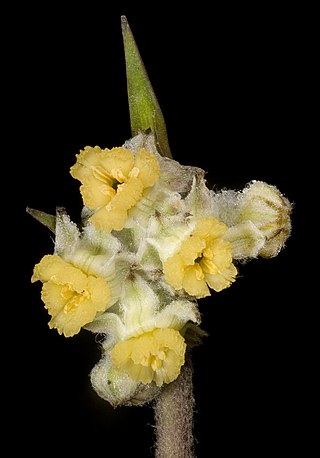
Banksia nobilis, commonly known as the golden dryandra, great dryandra or kerosene bush, is a shrub of the family Proteaceae which is endemic to Western Australia. It occurs on lateritic rises from Eneabba to Katanning in the state's Southwest Botanic Province. With large pinnatifid leaves with triangular lobes, and a golden or reddish pink inflorescence, it is a popular garden plant. It was known as Dryandra nobilis until 2007, when all Dryandra species were transferred to Banksia by Austin Mast and Kevin Thiele. There are two subspecies, B. nobilis subsp. nobilis and B. nobilis subsp. fragrans.

Banksia proteoides, commonly known as king dryandra, is a shrub endemic to Western Australia. It was known as Dryandra proteoides until 2007, when all Dryandra species were transferred to Banksia by Austin Mast and Kevin Thiele.
Conospermum acerosum, commonly known as needle-leaved smokebush, is a shrub endemic to Western Australia.
Conospermum glumaceum, commonly known as hooded smokebush, is a shrub endemic to Western Australia.

Conospermum stoechadis, commonly known as common smokebush, is a shrub endemic to Western Australia.
Conospermum stoechadis subsp. sclerophyllum is a shrub endemic to Western Australia.

Conospermum incurvum, commonly known as plume smokebush, is a shrub endemic to Western Australia.

Stirlingia, commonly known as blueboy, is a genus of 7 species in the family Proteaceae, all of which are endemic to Western Australia.

Stirlingia simplex is a species of flowering plant in the family Proteaceae. It is endemic to Western Australia.

Gastrolobium spinosum, also known as prickly poison, is a shrub in the family Fabaceae. It is endemic to Southwest Australia
Plantago debilis is a species of herb native to Australia. Common names include shade plantain and weak plantain.

Thomasia grandiflora, commonly known as large-flowered thomasia, is endemic to the south-west of Western Australia. The flowers are pinkish-purple with a papery appearance hanging in pendents from the leaf axils. The calyx lobes are prominent and larger than the petals.

Laxmannia is a genus of tufted perennial herbs in the family Asparagaceae, subfamily Lomandroideae, that are endemic to Australia.

Calytrix aurea is a species of shrub in the family Myrtaceae, endemic to the south-west of Western Australia. It was first formally described by botanist John Lindley in 1839 in A sketch of the vegetation of the Swan River Colony.

Adenanthos barbiger, the hairy jugflower or hairy glandflower, is a species of shrub in the family Proteaceae. It is endemic to the south-west of Western Australia. It usually grows to 1 metre high, and has bright red flowers that appear mostly between August and December. The species was first formally described in 1839 by English botanist John Lindley in A sketch of the vegetation of the Swan River colony.

Scaevola platyphylla, commonly known as broad-leaved fanflower, is a shrub in the family Goodeniaceae. It is endemic to the south-west of Western Australia. Plants grow to between 0.3 and 1.3 metres high and have blue to purple flowers that appear between August and January in their native range.

Thelymitra villosa, commonly called the custard orchid is a species of orchid which is endemic to Western Australia. It has a single erect, hairy leaf and up to twenty yellow flowers with reddish-brown markings.

Laxmannia squarrosa is a species of Laxmannia, a genus of tufted perennial herbs in the family Asparagaceae, subfamily Lomandroideae, which is endemic to Western Australia. From 0.03 to 0.1 m high, it grows on gravel and lateritic sand, and its white flowers may be seen from September to November.

Burchardia congesta is a perennial herb in the family Colchicaceae, and is native to Western Australia.

Tribonanthes brachypetala is a species of the genus Tribonanthes in the bloodwort family, Haemodoraceae native to south western Western Australia.


















